Take Me Home! A Princess of Mars by Edgar Rice Burroughs
I opened my eyes upon a strange and weird landscape. I knew that I was on Mars; not once did I question either my sanity or my wakefulness. I was not asleep, no need for pinching here; my inner consciousness told me as plainly that I was upon Mars as your conscious mind tells you that you are upon Earth. You do not question the fact; neither did I.
So reacts John Carter, ex-cavalryman of the Army of Northern Virginia, when he transmigrates to the red planet in A Princess of Mars (1917). Chased by torture-minded Apaches, Carter secrets himself in a cave. By unknown means, he finds his spirit severed from his body and transported to Mars.
On Mars, a dying, barren world littered with the ruins of millennia-gone civilizations, he finds his great love and becomes the greatest hero that Barsoom, as its inhabitants call Mars, has ever known. Along that path to glory, thousands of miles are traveled and thousands of foes slain. A Princess of Mars is pure escapist fantasy, where the protagonist, standing in for the increasingly civilized American man Burroughs was writing for, fights and defeats all foes, outwits every enemy, and wins the hand of the most beautiful woman in the world. To some, that might sound juvenile, but they are wrong. A Princess of Mars is absolutely deserving of the mind-blowingly pulpy cover illustrations of Frank Frazetta.
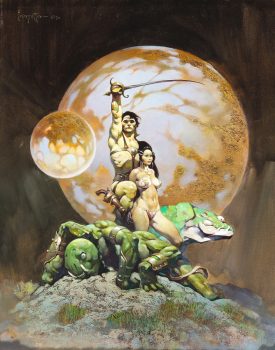 Edgar Rice Burroughs’ second published novel (initially serialized in The All-Story magazine in 1912) is one of the foundational novels of modern heroic fiction. It’s the first sword and planet story, a genre where low technology exists beside super-science on distant, exotic worlds, and there’s little concern about scientifically sound explanations for it all. Adventure, excitement, danger, great romance, these are the foremost concerns. When done right, it’s a blast of pure literary joy. If you don’t believe me, take Ray Bradbury’s word for it when he said if he hadn’t read the John Carter novels when he was young, The Martian Chronicles would never have been written.
Edgar Rice Burroughs’ second published novel (initially serialized in The All-Story magazine in 1912) is one of the foundational novels of modern heroic fiction. It’s the first sword and planet story, a genre where low technology exists beside super-science on distant, exotic worlds, and there’s little concern about scientifically sound explanations for it all. Adventure, excitement, danger, great romance, these are the foremost concerns. When done right, it’s a blast of pure literary joy. If you don’t believe me, take Ray Bradbury’s word for it when he said if he hadn’t read the John Carter novels when he was young, The Martian Chronicles would never have been written.
I would go out to that lawn on summer nights and reach up to the red light of Mars and say, “Take me home!” I yearned to fly away and land there in the strange dusts that blew over dead-sea bottoms toward the ancient cities.
Ray Bradbury from “Take Me Home” in The New Yorker June 4 & 11, 2012 Issue
A Princess of Mars forms a single story with its two immediate sequels, The Gods of Mars (serialized 1913) and The Warlord of Mars (serialized 1913/1914). Together they tell the saga of John Carter’s journey to Barsoom and rise to power as Warlord of Mars. I read all three over forty years ago and my memories of them were faded and the ones that remained were definitely affected by watching the recent film adaptation of Princess, John Carter (2012). As fun as the movie is, it barely hints at the intensity of A Princess of Mars. The book is just a little insane and a lot over-the-top.
Upon arriving on Barsoom stark naked (as are all Barsoomians, a fact neglected by most illustrators, but not all), Carter discovers that his Earth-formed musculature allows him to perform incredible feats of strength due to Mars’s lower gravity. This serves him in good stead when he is surprised by a band of four-armed, befanged green men.
The man himself, for such I may call him, was fully fifteen feet in height and, on Earth, would have weighed some four hundred pounds. He sat his mount as we sit a horse, grasping the animal’s barrel with his lower limbs, while the hands of his two right arms held his immense spear low at the side of his mount; his two left arms were outstretched laterally to help preserve his balance, the thing he rode having neither bridle or reins of any description for guidance.
And his mount! How can earthly words describe it! It towered ten feet at the shoulder; had four legs on either side; a broad flat tail, larger at the tip than at the root, and which it held straight out behind while running; a gaping mouth which split its head from its snout to its long, massive neck.
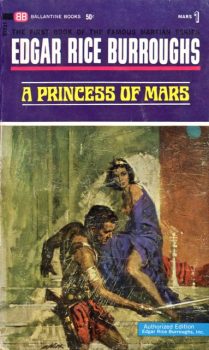 The green Martians are savage warriors who find their greatest joy in torturing captives. Carter’s feats of leaping and killing a green Martian with one blow win him the guarded approval of the tribe. Among the tribe he encounters, the Tharks, the Earthman is befriended by their vice-chieftain, Tars Tarkas, and a young woman named Sola. He also acquires a Barsoomian guard dog, Woola.
The green Martians are savage warriors who find their greatest joy in torturing captives. Carter’s feats of leaping and killing a green Martian with one blow win him the guarded approval of the tribe. Among the tribe he encounters, the Tharks, the Earthman is befriended by their vice-chieftain, Tars Tarkas, and a young woman named Sola. He also acquires a Barsoomian guard dog, Woola.
Sola motioned me to be seated upon a pile of silks near the center of the room, and, turning, made a peculiar hissing sound, as though signaling to someone in an adjoining room. In response to her call I obtained my first sight of a new Martian wonder. It waddled in on its ten short legs, and squatted down before the girl like an obedient puppy. The thing was about the size of a Shetland pony, but its head bore a slight resemblance to that of a frog, except that the jaws were equipped with three rows of long, sharp tusks.
When a squadron of flying ships is attacked, and one of their number shot down by the Tharks, Carter discovers the green Martians are not the sole inhabitants of Barsoom. He also meets the woman with whom all that he is and will be is to be intertwined; Dejah Thoris, princess of the great city of Helium.
And the sight which met my eyes was that of a slender, girlish figure, similar in every detail to the earthly women of my past life. She did not see me at first, but just as she was disappearing through the portal of the building which was to be her prison she turned, and her eyes met mine. Her face was oval and beautiful in the extreme, her every feature was finely chiseled and exquisite, her eyes large and lustrous and her head surmounted by a mass of coal black, waving hair, caught loosely into a strange yet becoming coiffure. Her skin was of a light reddish copper color, against which the crimson glow of her cheeks and the ruby of her beautifully molded lips shone with a strangely enhancing effect.
She was as destitute of clothes as the green Martians who accompanied her; indeed, save for her highly wrought ornaments she was entirely naked, nor could any apparel have enhanced the beauty of her perfect and symmetrical figure.
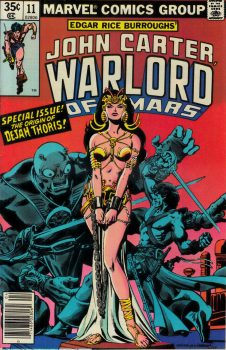 What follows from that initial glimpse of the incomparable Dejah Thoris is a welter of escapes, duels, journeys, gladiatorial contests, arranged marriages that must be stopped, vast aerial battles, and a great siege. Monsters and sudden and bloody death abound. Coincidence seems to rule the flow of much of the plot and almost every problem is solved by feats of daring or feats of arms. It ends with a massive cliffhanger. The villains are all villainous, and the heroes heroic, John Carter, obviously, the most heroic of them all.
What follows from that initial glimpse of the incomparable Dejah Thoris is a welter of escapes, duels, journeys, gladiatorial contests, arranged marriages that must be stopped, vast aerial battles, and a great siege. Monsters and sudden and bloody death abound. Coincidence seems to rule the flow of much of the plot and almost every problem is solved by feats of daring or feats of arms. It ends with a massive cliffhanger. The villains are all villainous, and the heroes heroic, John Carter, obviously, the most heroic of them all.
I did not need a manual of green Martian etiquette to know what reply to make, for, in fact, I was so wild with anger that I could scarcely refrain from drawing my pistol and shooting him down for the brute he was; but he stood waiting with drawn long-sword, and my only choice was to draw my own and meet him in fair fight with his choice of weapons or a lesser one.
This latter alternative is always permissible, therefore I could have used my short-sword, my dagger, my hatchet, or my fists had I wished, and been entirely within my rights, but I could not use firearms or a spear while he held only his long-sword.
I chose the same weapon he had drawn because I knew he prided himself upon his ability with it, and I wished, if I worsted him at all, to do it with his own weapon. The fight that followed was a long one and delayed the resumption of the march for an hour. The entire community surrounded us, leaving a clear space about one hundred feet in diameter for our battle.
Zad first attempted to rush me down as a bull might a wolf, but I was much too quick for him, and each time I side-stepped his rushes he would go lunging past me, only to receive a nick from my sword upon his arm or back. He was soon streaming blood from a half dozen minor wounds, but I could not obtain an opening to deliver an effective thrust. Then he changed his tactics, and fighting warily and with extreme dexterity, he tried to do by science what he was unable to do by brute strength. I must admit that he was a magnificent swordsman, and had it not been for my greater endurance and the remarkable agility the lesser gravitation of Mars lent me I might not have been able to put up the creditable fight I did against him.
In fact, one of the strongest elements in A Princess of Mars and the weakest in the film John Carter is John Carter’s nature. In the film, he is a psychically wounded man mourning the murder of his family and unwilling to fight for a cause. That is assuredly not Burroughs’ creation. In the novel, one of the most appealing aspects of John Carter is his heroism and his willingness to do anything and everything, including the total destruction of an entire city, to secure the safety of Dejah Thoris. It is the man he is from the first pages. He doesn’t need to be convinced of the need to save Helium; all Dejah Thoris need do is ask and he will. A similar tack was taken with the character of Aragorn in Peter Jackson’s Lord of the Rings movies. It’s as if a boldly heroic character lacking self-doubt or reluctance isn’t believable anymore.
Barsoom is described in great and wonderful detail by Burroughs. Based on 19th-century ideas that Mars was a dry and dying planet inhabited by beings who dredged canals to channel driblets of water from the polar ice cap, Burroughs imagines a withering world with only a few great cities remaining. We learn how the farms are fed by underground irrigation in order to reduce evaporation. Even the oxygen is fading away and only the great Atmosphere Plants, psychically maintained factories, keep the air of Barsoom breathable. The planet is largely a wasteland filled with savages and the broken remains of ancient races. Because Barsoom is so violent, locks can’t keep predators at bay, so the houses of the red Martians elevate at night on great pillars for safety. The customs of the green and red Martians, from family rearing to the etiquette of dueling and killing a woman’s intended, are described in detail.
The non-John Carter characters are a memorable lot and get their own elements or moments of coolness. Tars Tarkas possesses honor and loyalty that elevate him above most of his fellow green Martians, while Sola is the only of her people to show empathy and kindness. Dejah Thoris proves elusive on the page, captured repeatedly and buffeted around by the winds of fate as she is. Her flashes of bravery and boldness, though, show her to be the perfect match for Carter. The villains are all delightfully awful and drawn in perfectly garish colors as is the vile Thark chief, Tal Hajus.
“Princess of Helium, I might wring a mighty ransom from your people would I but return you to them unharmed, but a thousand times rather would I watch that beautiful face writhe in the agony of torture; it shall be long drawn out, that I promise you; ten days of pleasure were all too short to show the love I harbor for your race. The terrors of your death shall haunt the slumbers of the red men through all the ages to come; they will shudder in the shadows of the night as their fathers tell them of the awful vengeance of the green men; of the power and might and hate and cruelty of Tal Hajus. But before the torture you shall be mine for one short hour, and word of that too shall go forth to Tardos Mors, Jeddak of Helium, your grandfather, that he may grovel upon the ground in the agony of his sorrow. Tomorrow the torture will commence; tonight thou art Tal Hajus’; come!”
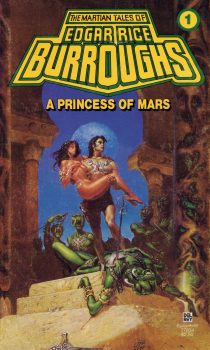 And then there’s the crazy stuff. Like that all Martians are capable of reading each other’s thoughts to a certain degree, though it really only comes into play when it matters to the plot. Oh, and all Martians, including the perfectly human-looking Dejah Thoris are oviparous — by which I mean they lay eggs that then develop for five years and give birth to toddlers. Oh, and John Carter is perfectly sexually compatible with her. Oh, and even though they lay eggs, the women of Barsoom still have breasts. It’s all a little nutty, and none of it matters to me. Not in the least.
And then there’s the crazy stuff. Like that all Martians are capable of reading each other’s thoughts to a certain degree, though it really only comes into play when it matters to the plot. Oh, and all Martians, including the perfectly human-looking Dejah Thoris are oviparous — by which I mean they lay eggs that then develop for five years and give birth to toddlers. Oh, and John Carter is perfectly sexually compatible with her. Oh, and even though they lay eggs, the women of Barsoom still have breasts. It’s all a little nutty, and none of it matters to me. Not in the least.
In addition to inspiring a whole subgenre of fiction, and authors like Leigh Brackett and Edmond Hamilton, Edgar Rice Burroughs’ Barsoom stories were imitated by several authors, some to the good and some to the bad. Michael Moorcock, who as a teenager edited Tarzan Adventures (a national juvenile weekly magazine with stories and comics) wrote an explicit pastiche, Warrior of Mars trilogy. Again, it’s been ages since I read them, but my memory of them is Burroughs’ brand of adventure story was well-served by Moorock’s own madcap inventiveness. On the other hand, there’s the repulsive Gor series which just saw its 36th published title as its creator, John Norman, entered his tenth decade. Sword and planet stories may be rare today, but all the old books are available, some even for free. In fact, all the Barsoom novels can be found at Project Gutenberg or Project Gutenberg Australia.
A Princess of Mars may not be to everyone’s taste, but it is to mine. I’ve written numerous times here and elsewhere that the purpose of heroic fiction (and all the associated genres) is to undo the chains of mundanity that bind most of us to our workaday routines and grant us a glimpse of limitless horizons and a taste of daring deeds and heroism. This book is a boldly colored jolt adventure pulsing with the purest pulp electricity that will course through and astound any but the most jaded readers. I will definitely be continuing my way through more of Burroughs’ Martian tales before long.
Fletcher Vredenburgh writes a column each first Friday of the month at Black Gate, mostly about older books he hasn’t read before. He also posts at his own site, Stuff I Like when his muse hits him.
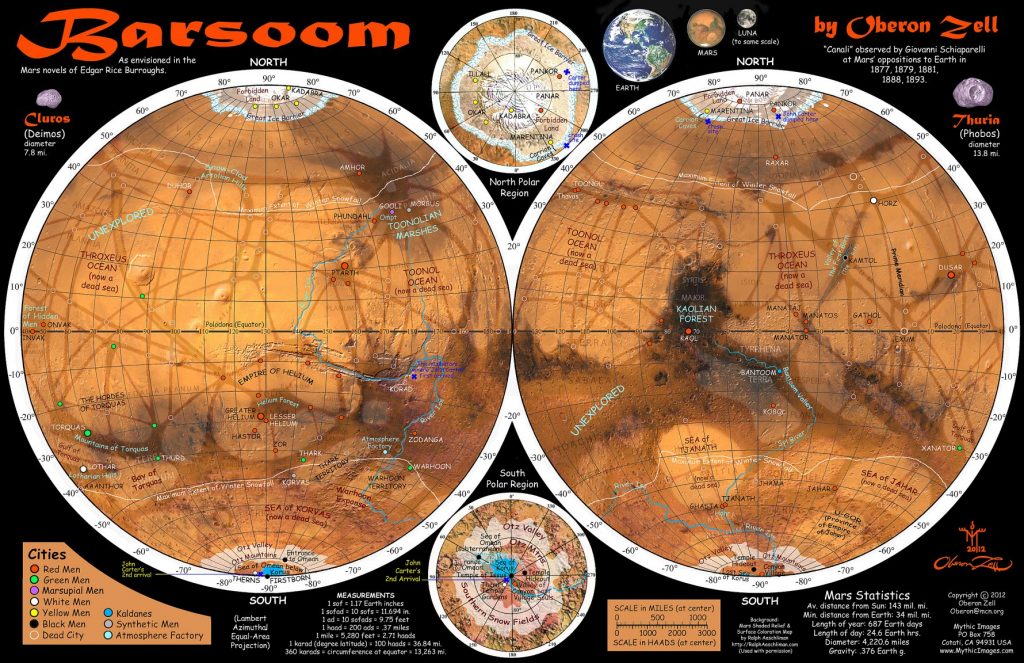
Plucking the Ace edition of A Princess of Mars (with the great Gino D’Achille cover) from the drugstore spinner rack was one of the great events of my life. I was in the seventh grade, and nothing was ever the same. I became a Burroughs fanatic and devoured everything of his I could lay may hands on. Since it was smack in the middle of the Burroughs paperback boom of the 60’s and 70’s, that was easy. Barsoom, Pellucidar, Amtor, Trazan’s Africa all became as familiar as my hometown.
Returning to ERB as an adult, I’m conscious of his many defects, but he still remains an unparalleled master, a supreme magician of the imagination.
I’ve only read the first three Barsoom books and the three Caspak books. I definitely need to read more. And, yeah, defects be damned, this is fun, fun stuff!
The Caspak books are excellent, yes, and the Moon Maid and Moon Men, and The Mucker, and, and… Gore Vidal – of all people – once said that ERB was the greatest writer of pure action ever. I think I agree (the slave rising in the arena of Issus in Gods of Mars, for instance).
Anyone who loves Burroughs needs to read Master of Adventure by Richard Lupoff. It was my bible back in the day.
Thanks for the recommendation Thomas, I will add Richard Lupoff th “the list”.
Way back a friend at work convinced me to try these and step away from my somewhat slavish view of Robert E Howard being the only pulp writer worth reading. I devoured them still have fond memories of the books. I can’t recall how far I got, maybe I even finished the series. A direct link to why I have the Carson of Venus, Moon Maid/Men and others gracing my shelf now.
on of the first series i read as a younger self… i say read but i should say TRIED to read since every time i hit the local Waldenbooks they would have just a random number of the series, often many repeats but every once in a while a new # in the series would be available. i still dont think i have ever read them in order. the same for the tarzan books and a couple others that would be numbered.
i do admit though i loved stopping by every week just to see what was there, that continued on to comics as far as that discovery fun went.
I was in I think 7th or 8th grade when Dad gave me a copy of A Princess of Mars (with the Gino D’Achille cover; it’s just as well that was the current edition at the time; I’m not sure if he would’ve been comfortable giving me the Whelan cover) and it changed my world like nothing since Tolkien. They’re still some of my favorite books and I reread the series on a regular basis to be swept along by Burroughs’ wild imagination and thundering action (and monumentally improbable coincidences).
I think Gods of Mars may be the best thing he ever wrote. Of the later Barsoom novels, I also think Chessmen and Fighting Man in particular are great, although honestly, pretty much everything through Swords of Mars is worth your time; of all his series, the Barsoom books stay good for the longest. (All of his series had a tendency to flag somewhere after the midpoint, as he got tired of them and/or just found the formula and started writing to it.)
Joe, I completely agree about Gods of Mars being ERB’s best, though the one-two punch of At the Earth’s Core and Pellucidar comes pretty close. At the height of my fever I once read Chessmen of Mars in a single day. Ah, youth!
I grew up in that distant age myself, and I remember ordering ERB books from Ace by mail. This is my favorite book of all his. I still have most of his books except the Tarzan books on my book shelves. I read the first three Mars books to the kids when they were small. The funny thing is that looking back, I see that I rated his Venus books higher, and while I occasionally revisit this book, I’ve never had any desire to reread the Venus books.
This is the book that started it all for me; it was one of my father’s favorites and his gift of the first three martian novels started me down the path of Adventure. I have yet to reach its end. I second Mr. Parker’s recommendation of Dick Lupoff’s Master of Adventure; it is both very readable and complete.
Thanks for everything, Mr. Burroughs, and thank you Mr. Vredenburgh for a great post.